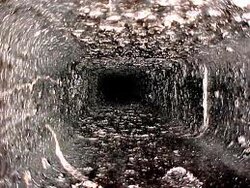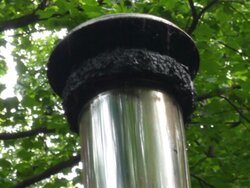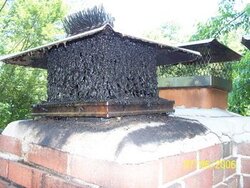Can someone tell me witch part of the burn produces creosote the first 15 minutes or during the middle?
Stages of burning wood?
- Thread starter corey21
- Start date
-
Active since 1995, Hearth.com is THE place on the internet for free information and advice about wood stoves, pellet stoves and other energy saving equipment.
We strive to provide opinions, articles, discussions and history related to Hearth Products and in a more general sense, energy issues.
We promote the EFFICIENT, RESPONSIBLE, CLEAN and SAFE use of all fuels, whether renewable or fossil.
You are using an out of date browser. It may not display this or other websites correctly.
You should upgrade or use an alternative browser.
You should upgrade or use an alternative browser.
- Status
- Not open for further replies.
Backwoods Savage
Minister of Fire
Accumulation comes the most from start up where the pipe is cold/cool. After the pipe is hot if you make creosote it ends up on your neighbor's car.
Accumulation comes the most from start up where the pipe is cold/cool. After the pipe is hot if you make creosote it ends up on your neighbor's car.
Thank you.
So on reloads were the chimney is warm you don't get much.
But i figured at first you would make more as the wood breaks down.
Not if you don't smolder it. I got curious one day and took the IR thermo with me when I went up to check the liner. The stove was at 400 coming down. The inside top of the 21' liner was 240 degrees. A few degree hotter than the boiling point of water and condensation is what lets the stuff stick to the flue pipe wall.
Burn'er hot and and don't turn it down too soon it won't be a problem. And I don't care how dry your wood is, burn it too cool and you make creosote. There is moisture in any fresh load of wood not to mention the humidity in the room air entering the stove and heading up the pipe.
Burn'er hot and and don't turn it down too soon it won't be a problem. And I don't care how dry your wood is, burn it too cool and you make creosote. There is moisture in any fresh load of wood not to mention the humidity in the room air entering the stove and heading up the pipe.
Not if you don't smolder it. I go curious one day and took the IR thermo with me when I went up to check the liner. The stove was at 400 coming down. The inside top of the 21' liner was 240 degrees. A few degree hotter than the boiling point of water and condensation is what lets the stuff stick to the flue pipe wall.
Burn'er hot and and don't turn it down too soon it won't be a problem. And I don't care how dry your wood is, burn it too cool and you make creosote. There is moisture in any fresh load of wood not to mention the humidity in the room air entering the stove and heading up the pipe.
The real reason why i thought i would ask about this is because sometimes this year i let the stove run at like 450. But my probe says i am doing fine once i get it cruising But i always keep flames going i dont smolder it.
One of the problems I have with pipe thermometers. 18" above the flue collar doesn't tell ya squat about what is happening up top. The pipe is cooler every foot you move up it all the way to the sky.
I mean 450 on the side of the stove.
I know. 450 on the side of a non-cat, if that thermo isn't behind the firebricks, tells you that the firebox isn't hot enough to support secondary combustion. Not a problem if you have sufficient fire going on in that firebox but a big problem if you have it shut down to a slow burn. If you monitor temps on the side of the firebox find a spot where there aren't bricks or the secondary air manifold on the other side inside the firebox. On most steel stoves that is above the firebricks and below the manifold. That spot you found before that was so hot.
I know. 450 on the side of a non-cat, if that thermo isn't behind the firebricks, tells you that the firebox isn't hot enough to support secondary combustion. Not a problem if you have sufficient fire going on in that firebox but a big problem if you have it shut down to a slow burn. If you monitor temps on the side of the firebox find a spot where there aren't bricks or the secondary air manifold on the other side inside the firebox. On most steel stoves that is above the firebricks and below the manifold. That spot you found before that was so hot.
It's the same spot. About what temp does it need to be for ideal secondary combustion? I understand that if i have a good wood fire going there want be that much secondary flames.
Sorry to bother ya with all these questions.
You can see where it starts. The flames will be licking at the baffle and the excess gases burning up at the tubes. All of mine start it around 500 degrees. Which would be about right since it occurs around 1100 degrees inside the firebox.
You can see where it starts. The flames will be licking at the baffle and the excess gases burning up at the tubes. All of mine start it around 500 degrees. Which would be about right since it occurs around 1100 degrees inside the firebox.
I ask a dumb question that last one.
Something that has been on my mind for a few weeks i am thinking very severely about replacing the mag with the NC 30 I can give you the reasons why if you are wondering.
Don't know why you would want to but I am wondering.
The baffle in the mag is welded in witch makes things tough when time to clean the pipes.
It don't have a dog house air witch i think it could use one.
The emissions on the 30 are much lower witch i think would give me more heat less creosote.
D
DexterDay
Guest
The baffle in the mag is welded in witch makes things tough when time to clean the pipes.
It don't have a dog house air witch i think it could use one.
The emissions on the 30 are much lower witch i think would give me more heat less creosote.
No doghouse?? My Uncles US 2000 has a spot in the front where air comes in? There isnt any place in the bottom front for air?
Although the 2000 has a baffle board like the 30, I dont think that the emissions will reduce overall.Sote that much.
But the 30 is one hell of a heater

Green Energy
Feeling the Heat
Cresote is primarily the results of incomplete combustion. If you have adequate secondary combustion, than you reduce the main source of cresote.
Keeping the flue pipe wall, to the flue cap, temperature above 212 F helps to keep the products of combustion from condensing on the flue.
Keeping the flue pipe wall, to the flue cap, temperature above 212 F helps to keep the products of combustion from condensing on the flue.
No doghouse?? My Uncles US 2000 has a spot in the front where air comes in? There isnt any place in the bottom front for air?
Although the 2000 has a baffle board like the 30, I dont think that the emissions will reduce overall.Sote that much.
But the 30 is one hell of a heater
No air hole just welds on the stove body and no air holes in the legs.
The Mag has to be a hot burning heater if it needs to be. A member here that had one burned the sucker so hot I can't believe it didn't melt down. Yeah. I am talking to you Bill. 

D
DexterDay
Guest
Im still thinking that there is an air inlet somewhere on the front?
Its an EPA stove correct?
The 30 has holes in the bottom front of the stove, but that does not mean thats where yours will be (its not in the legs, its behind the legs, but on the firebox itself).
Can you sweep the ashes away from the front of the box and post a pic? I am almost positive there is something there?
The Mag is a pretty decent sized stove. Loaded properly, it should kick the heat and glow red if not watched.
Its an EPA stove correct?
The 30 has holes in the bottom front of the stove, but that does not mean thats where yours will be (its not in the legs, its behind the legs, but on the firebox itself).
Can you sweep the ashes away from the front of the box and post a pic? I am almost positive there is something there?
The Mag is a pretty decent sized stove. Loaded properly, it should kick the heat and glow red if not watched.
Machria
Minister of Fire
What's with all the "creosote" discussions on this site? I just removed a 20 year old chimney from an old inefficient insert fireplace that was NEVER cleaned in 20 years. Not once. The chimney was perfectly clean, nothing but a finger swipe coating of black soot as expected in a chimney.
I say give the creosote a rest already.
I say give the creosote a rest already.
What's with all the "creosote" discussions on this site? I just removed a 20 year old chimney from an old inefficient insert fireplace that was NEVER cleaned in 20 years. Not once. The chimney was perfectly clean, nothing but a finger swipe coating of black soot as expected in a chimney.
I say give the creosote a rest already.
The chimney fires I had for 20 years left mine clean too.
D
DexterDay
Guest
What's with all the "creosote" discussions on this site? I just removed a 20 year old chimney from an old inefficient insert fireplace that was NEVER cleaned in 20 years. Not once. The chimney was perfectly clean, nothing but a finger swipe coating of black soot as expected in a chimney.
I say give the creosote a rest already.
Fireplaces are a wide open air chamber. Cant be choked down to a smother like a wood stove.
Have you seen pics of some of the chimneys here?
What's with all the "creosote" discussions on this site? I just removed a 20 year old chimney from an old inefficient insert fireplace that was NEVER cleaned in 20 years. Not once. The chimney was perfectly clean, nothing but a finger swipe coating of black soot as expected in a chimney.
I say give the creosote a rest already.
Okey Dokey...then we also give stove installation and operation and wood processing/seasoning a rest, as well? Codes? The environment? How about everything we've learned over the years about safe, effective, efficient woodburning to keep our families warm AND SAFE at the same time. Should we give that all a rest? I'm sure the chimney/flue you're talking about was clean as a whistle after 20-some years of burning. They're not all found to be quite that way.


They're not all found to be quite that way.
And having gone up one month and looked and saw mine like the first pic and the next month it was nothing but a wisp of soot I know how it got that way.

- Status
- Not open for further replies.
Similar threads
- Replies
- 23
- Views
- 1K
- Replies
- 39
- Views
- 2K
- Replies
- 21
- Views
- 588


